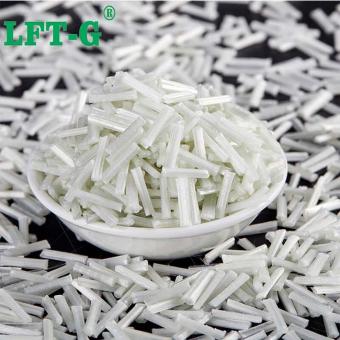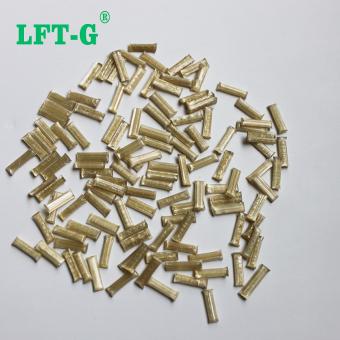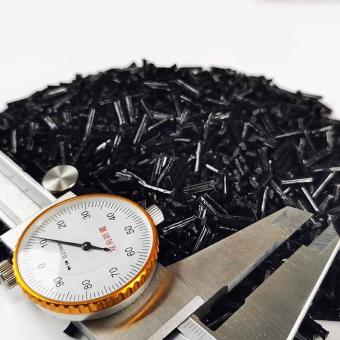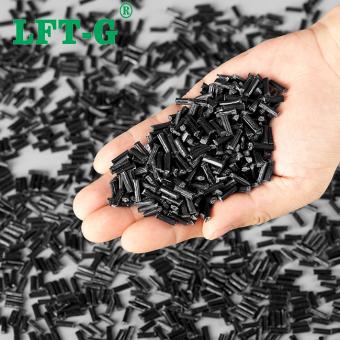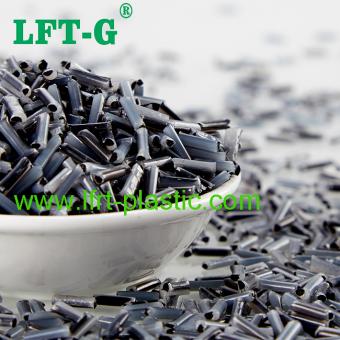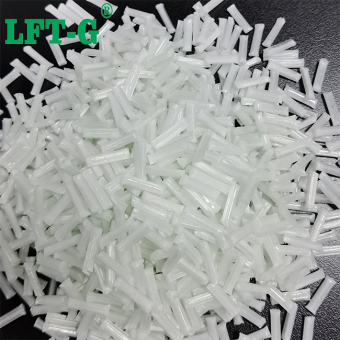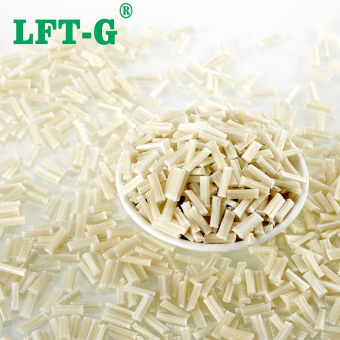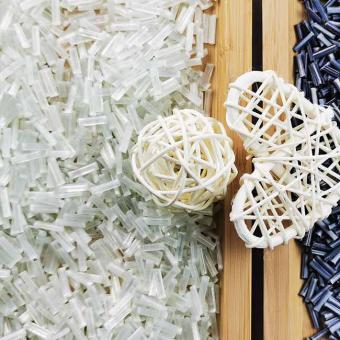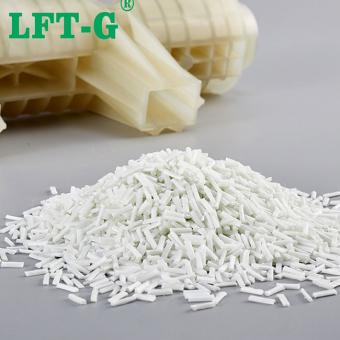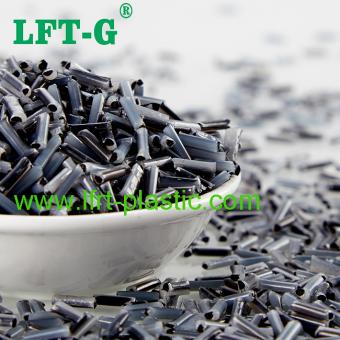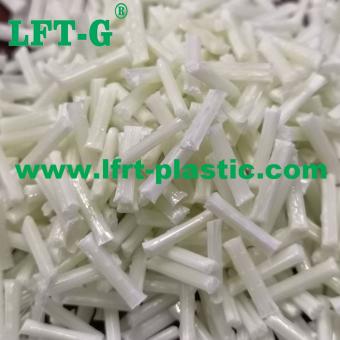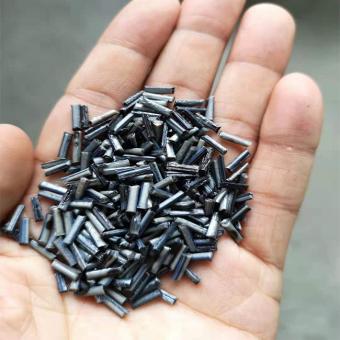-
LFT-G PA66 Nylon66 plastic natural color for electronic appliancesProduct number: PA66-LGF Fiber specification: 20%~60% Product grade: General grade, Toughen resistance gradeview more
-
Raw material PPS composite long glass fiber for home appliances partsProduct number: PPS-NA-LGF Fiber specification: 20%-60% Feature: 94-VO Flame retardant, high toughness, low warpage, fatigue resistance, good appearance of the product Application: Water heater impeller, pump shell, joint, valve, chemical pump impeller, shell, cooling water impeller, shell, home appliances partsview more
-
lft-g brand PLA compounds fill long carbon fiber 20%-60% high performance low warpage natural colorWhat is carbon fiber PLA? Carbon fiber reinforced PLA is an excellent material, strong, lightweight, with excellent layer bonding and low warpage. It has excellent layer adhesion and low warpage. Carbon fiber filaments are not as strong" as other 3D materials, but are much stiffer. The increased rigidity of carbon fiber means increased structural support, but reduced overall flexibility. It is slightly more brittle than regular PLA. Carbon PLA Specifications Flexural strength: 57 MPa Melting temperature: 190°C- 230°C Tensile strength: 45.5 MPa . Elongation at break: (73°F) 320% Standard tolerance: 0.05mm Layer thickness: 3mm Shore hardness: 45D Density: 1.3 g/cm3 (1300 kg/m3) Heat distortion: 21% to 85°C Shrinkage: very low when cooled to higher ambient temperatures Characteristics Moderate strain at break (8-10%), so the filaments are not very brittle, but very tough Very high melt strength and viscosity Good dimensional accuracy and stability Easy handling on many platforms Highly attractive matte black surface Excellent impact resistance and lightness Applications of carbon fiber PL A material Carbon PLA is the ideal material for frames, supports, housings, propellers, chemical instruments, etc. It is also particularly preferred by drone manufacturers and RC enthusiasts. Ideal for applications requiring maximum stiffness and strength. Other products you may wonder PA6-LCF PP-LCF PEEK-LCF About Long carbon fiber Long carbon fiber reinforced composites offer siginifacant weight savings and provide optimum strength and stiffness properties in reinforced thermoplastics. The excellent machanical properties of long carbon fiber reinforced composites make it an ideal replacement for metals. Combined with the design and manufacturing advantages of injection molded thermoplastics, long carbon fiber composites simplify the re-imagining of components and equipment with demanding performance requirements. Its widespread use in aerospace and other advanced industries makes it a "high-tech" perception of consumers - you can use it to market products and create differentiation from competitors. About us Xiamen LFT composite plastic Co., Ltd is a brand-name company that focuses on LFT&LFRT. Long Glass Fiber Series (LGF) & Long Carbon Fiber Series (LCF). The company's thermoplastic LFT can be used for LFT-G injection molding and extrusion, and can also be used for LFT-D molding. It can be produced according to customer requirements: 5~25mm in length. The company's continuous infiltration reinforced thermoplastics have passed ISO9001&16949 system certification, and the products have obtained lots of national trademarks and patents. We can offer you: 1. LFT & LFRT material technical parameters and leading edge design. 2. Mold front design and recommendations. 3. Provide technical support such as injection molding and extrusion molding.
- Low warpage electronic appliance
- PLA pellets lcf 30 polymer
- high strength and high toughness reinforced pla pellets
- plastic pla lcf30
- best long carbon fiber pla lcf30 granules
- pla cf20 pla granule price
Tags :
-
LFT-G Homo PP fill Long carbon fiber LGF 20-60 injection molding high toughness and strength 12mmWhat is the Homo PP? Homopolymerized PP plastics are made by polymerizing a single propylene monomer and do not contain ethylene monomer in the molecular chain. Homopolymerized polypropylene pp plastic has the advantage of better strength. Disadvantages are poor impact resistance (more brittle), poor toughness, poor dimensional stability, easy aging, and poor long-term heat stability performance. PP as a thermoplastic polymer began commercial production in 1957, is the first of the regulated stand-alone polymers. Its historical significance is further reflected in the fact that it has been the fastest growing major thermoplastic and has a very wide range of applications within the thermoplastic field, especially in fiber and filament, film extrusion, and injection molding processes. HPP-LCF Long carbon fiber reinforced composites offer significant weight savings and provide optimum strength and stiffness properties in reinforced thermoplastics. The excellent mechanical properties of long carbon fiber reinforced composites make it an ideal replacement for metals. Combined with the design and manufacturing advantages of injection molded thermoplastics, long carbon fiber composites simplify the re-imagining of components and equipment with demanding performance requirements. Its widespread use in aerospace and other advanced industries makes it a "high-tech" perception of consumers - you can use it to market products and create differentiation from competitors. Application You can contact us for more detailed information about application Datasheet for your reference Long carbon fiber Xiamen LFT composite plastic Co., Ltd Xiamen LFT composite plastic Co., Ltd is a brand-name company that focuses on LFT&LFRT. Long Glass Fiber Series (LGF) & Long Carbon Fiber Series (LCF). The company's thermoplastic LFT can be used for LFT-G injection molding and extrusion, and can also be used for LFT-D molding. It can be produced according to customer requirements: 5~25mm in length. The company's continuous infiltration reinforced thermoplastics have passed ISO9001&16949 system certification, and the products have obtained lots of national trademarks and patents.
- self owing PP pellets
- high strength and high toughness reinforced pp pellets
- pp cf40 for electrical connector price
- superior waterproof pp granules
- reinforced Polypropylene PP virgin pure materials
Tags :
-
lft-g PA66 nylon66 filling long carbon fiber 20%-60% modified plastic higher performance natural colorMaterial Introduction In 1935, Wallace Carothers, a scientific researcher at DuPont, and his team successfully synthesized PA66 by condensation of adipic acid and adipic diamine for the first time, and DuPont completed the commercial production of PA66 fiber in 1939. Starting in the 1950s, PA, including PA6 and PA66, was developed for the production of injection molded products to replace metal to meet the requirements of light weight and cost reduction of industrial products. At present, PA66 is the most used PA species other than PA6. PA66 Scientific name: Polyhexanediamide Abbreviation: PA66 Common name: Nylon 66 PA66 has many similarities with PA6. PA66 is also a transparent to milky white granule that can take on almost any color with the addition of a colorant (masterbatch) specific for polymers. Material properties Similar to the basic properties of PA6, PA66 also has low specific gravity, high tensile strength, wear resistance, good self-lubrication, and excellent impact toughness. In addition, because the number of hydrogen bonds in PA66 is more than in PA6, the intermolecular force of PA66 is stronger than the intermolecular force of PA6, which makes the internal structure of PA66 more compact than PA6, with better thermal properties, higher rigidity and toughness, better dimensional stability, lower water absorption, and more wear resistance. However, PA66 has a higher market price than PA6 and is not as easy to process and mold as PA6. Like PA6, PA66 can also add a certain percentage of glass fiber, carbon fiber, etc. to improve the performance and meet the application needs of different products. The following table is a PA66-LCF30 performance table produced by Xiamen LFT composite plastic company. Materials Application PA66 has higher hardness, mechanical strength, toughness, self-lubrication, friction resistance, heat resistance after the addition of carbon fiber, and is widely used in automotive parts, electrical and electronic, as well as mechanical and engineering parts and other fields. Automotive parts PA66's low specific gravity, high rigidity, strong toughness, heat resistance and gasoline resistance make it widely used in automotive modules, automotive structural parts, automotive interior and exterior parts, automotive transmission system and chassis shield, automotive fuel system, automotive ignition system, etc. The products involve automotive cable channel modules, structural parts of front-end components of automotive sunroof system, automotive rearview mirror bracket, automotive radiator, headlight support frame, door module, seat structural parts, seat shell and backrest, dashboard skeleton, air cooler fan, etc. Electrical and electronics PA66's good insulation, flame retardancy and corrosion resistance make it suitable for making various connectors, switches, sockets, terminal blocks, wire coverings, wire ties, insulating spacers, circuit breaker housings, transformer bobbins, retaining clips and motor parts after glass fiber reinforcement. Mechanical and engineering parts PA66's good rigidity, toughness, self-lubricating properties, heat and abrasion resistance make it suitable for manufacturing various nuts, screws, cable ties, worm gears, rotating wheels, gears, pump impellers, pulley sleeves, bushings, solenoid distribution valve seats, power tool housings, pipes, luggage racks, fan housings, appliance housings, door and window frames, cable drag chains and large machine tool baffles. Details Number Color Length Sample Package MOQ Delivery time Port of Loading PA66-NA-LCF30 Natural color (can be customized) 12mm about (can be customized) Available 20kg/bag 20kg 7-15 days after shipment Xiamen Port Other products you may wonder pa6-lcf pa12-lcf peek-lcf Frequently asked questions Q. How to choose the reinforcement method and length of the material when using long fiber reinforced thermoplastic material? A. The selection of materials depend on the requirements of the products. It is necessary to access how much the content is enhanced and how much length is more appropriate, which are depending on the performance requirements of the products. Q. Under what circumstances can long fiber replace short fiber? What are the common alternative materials? A. Traditional staple fiber materials can be replaced with long glass fiber and long carbon fiber LFT materials in the case of customers whose mechanical properties cannot be met or where higher metal substitutes are desired. For example, PP long glass fiber is often replacing nylon reinforced glass fiber, and nylon long glass fiber is replacing PPS series. Q. Are there any special proc...
- self owing pa66 pellets
- high strength and high toughness reinforced pa66 pellets
- reinforced polyamide66 lcf
- polyamide 66 engineering plastics lcf
- PA66 6 twin screw lcf pellets
- recycle thermoplastic pa66 long carbon fiber
Tags :
-
LFT-G PP Polyphenylene compounds long glass fiber thermoplastic resin original color sample availablePP fill Long glass fiber Advantages of glass fiber reinforced PP material in modified PP material. 1、The heat resistance temperature of glass fiber reinforced PP is much higher. 2、The shrinkage of glass fiber reinforced PP decreases a lot, and the rigidity is greatly improved. 3, glass fiber reinforced PP plastic, will not stress cracking, impact resistance improved a lot. 4、After glass fiber reinforced, the burning performance of PP plastic is reduced a lot. 5、After glass fiber reinforcement, the strength of PP is improved, such as: tensile strength, compressive strength, bending strength. The disadvantages of glass fiber reinforced PP material in modified PP material. 1、After glass fiber reinforcement, the transparency of the material decreases. 2、After glass fiber reinforced, the toughness of PP decreases and the brittleness increases. 3、After glass fiber reinforced, the hygroscopic property of PP is greatly enhanced, therefore, it should be dried when injection molding. 4、After glass fiber reinforcement, the melt viscosity of PP increases, the fluidity becomes worse, and the injection pressure increases a lot. 5、After glass fiber reinforcement, the fluidity of PP material is poor, and the injection temperature of reinforced plastic is increased by 10℃-30℃. 6、After glass fiber reinforced, attention should be paid to the surface corrosion treatment and surface hardness treatment of the equipment. 7、After glass fiber reinforcement, during the injection process, glass fiber can enter the surface of plastic products, making the surface of the products become rough. It is necessary to use the mold temperature machine to heat the mold when injection molding, so that the plastic polymer can enter the surface of the products and obtain a higher surface quality. TDS for reference only We have general grade, heat-resistance grade, UV-resistance grade, toughen-resistance grade for you to choose. Application General grade: Car parts, washing machine parts, water pump parts, water treatment components, furniture parts, etc. Heat-resistance grade: Car front and back module, water tank frame, battery bracket, engine cover, skylight frame, etc. UV-resistance grade: Car handle, car mirror parts, battery case, truck outside pedal etc. Toughen resistance grade: Power tools, pump shell, pipe fittings etc. LGF VS SGF Frequently askes questions Q. Does long glass fiber and long carbon fiber injection have special requirements for injection molding machines and molds? A. There are certainly requirements. Especially from the product design structure, as well as the injection molding machine screw nozzle and mold structure injection molding process must consider the requirements of long fiber. Q. The causes and solutions for floating fibers for long glass fiber and long carbon fiber products. A. Due to the low temperature of the sol or the low temperature of the mold and the low injection molding pressure, the glass fiber and the resin can not be well compatible and diffused. The uneven temperature of the mold surface mold will cause the floating fiber problem, and can be solved by increasing the sol temperature, mold temperature and injection pressure. Q. Long glass fiber reinforced PP will reduce the toughness of the material and increase the brittleness. Is there any way to solve this problem? A. Long glass fiber and long carbon fiber will greatly enhance the impact and tensile strength of the substrate.
- best long glass fiber pp lgf30 granules
- pp gf30 for electrical connector price
- furniture polypropylene compounds lgf
Tags :
-
LFT-G modified nylon66 PA66 filling long glass fiber compounds toughen resistance grade for electronic appliancesPA66-LGF Information PA66 is one of the most produced and widely used polyester series products. It has high grain size, excellent tensile properties, bending properties, tensile strength and other material mechanical properties, and its excellent ultra-low temperature characteristics and organic chemical properties. It is a class of rubber products with wide range of application, stable characteristics, good mechanical properties, high quality insulation, low density, easy processing and molding, self-extinguishing, and good wear resistance. Therefore, it is widely used in vehicles, electronic and electrical, chemical materials, industrial equipment, instrument panels, construction projects and other industries. However, it has high water absorption, poor alkali resistance, dry ultra-low temperature impact, low compressive strength and easy to deform after absorbing moisture, which affects the reliability of goods specifications. People have improved PA66 in a variety of ways, adding PA66 chemical fiber is one of them. After adding glass fiber, its impact force, heat deformation, material mechanical properties, molding processability and acid resistance are significantly improved. Glass fiber is a class of functional raw materials with high quality characteristics. This utility model has the advantages of low cost, non-combustibility, high temperature resistance, acid resistance, high tensile strength, high impact compressive strength, low tensile strength, high quality insulation properties, high quality insulation properties, etc. It is usually used as a raw material to improve organic chemical polymers or functional materials and composites. The most important hazard of proportional limits to raw materials is mechanical properties. The material mechanical properties of modified PA66 are also related to the composition of glass fibers. The tensile strength, bending strength and impact compression strength of PA66 increase with the glass fiber composition after the addition of PA66 chemical fibers. The tensile and flexural strengths of the managed system increased linearly, but the glass fiber composition was 30%. The trend of increasing tensile and flexural strengths showed some improvement. The results show that PA66 can produce a reasonable page layer, which can reasonably transfer the ground stress between the matrix and page, and thus improve the compressive strength of the matrix. PA66-LGF TDS The datasheet was tested by Xiamen LFT, for your reference only. PA66-LGF Application Suitable for many fileds, other application you can ask for our technical advice. Details Number Color Length Sample MOQ Port of Loading Delivery time Payment terms PA66-NA-LGF30 Original color (can be customized) 12mm (can be customized) Available 25kg Xiamen Port 7-15 days after shipment Discussed Xiamen LFT composite plastic Co., Ltd Xiamen LFT composite plastic Co., Ltd. is a brand-name company that focuses on LFT&LFRT. Long Glass Fiber Series (LGF) & Long Carbon Fiber Series (LCF). The company's thermoplastic LFT can be used for LFT-G injection molding and extrusion, and can also be used for LFT-D molding. It can be produced according to customer requirements: 5~25mm in length. The company's long-fiber continuous infiltration reinforced thermoplastics have passed ISO9001 &16949 system certification, and the products have obtained lots of national trademarks and patents. We will offer you: 1. LFT&LFRT material technical parameters and leading edge design 2. Mold front design and recommendations 3. Provide technical support such as injection molding and extrusion molding.
- best long glass fiber pa66 lgf30 granules
- PA66 6 twin screw lgf pellets
- Long Fiber PA66 granules Application
Tags :
-
LFT-G TPU resin filling long glass fiber LGF30 engineering plastics reinforced compounds high tensile strengthTPU introduction Thermoplastic polyurethane (TPU) elastomers are linear polymers formed by the copolymerization of hard and soft chain segments, which have physical properties such as tensile, abrasion and heat resistance, and elasticity similar to rubber. Thanks to the excellent product performance, the application fields of TPU are expanding, including daily consumer goods, construction, medical, military, automotive, agriculture and many other fields. New products and applications are also emerging, such as large-diameter hoses (shale gas extraction), charging cables for new energy vehicles, foamed TPU (ETPU) sports shoes midsoles prepared by supercritical foaming process, invisible braces, etc. Fiber reinforced modified TPU composites TPU has good impact resistance, but in some applications, high modulus of elasticity and very hard material is required. Glass fiber reinforced modification is a common technical means to improve the elastic modulus of the material. Through modification, thermoplastic composites with many advantages such as high elastic modulus, good insulation, heat resistance, good elastic recovery, good corrosion resistance, impact resistance, low coefficient of expansion and dimensional stability can be obtained. Long glass fiber VS Short glass fiber Compared with the short fiber, long fiber has more excellent performance in mechanical properties. It is more suitable for large products and structural parts. It has 1-3 times higher toughness than short fiber, and the tensile strength is increased by 0.5-1 times. Thermoplastics VS Thermosets Thermosets: when heated for the first time, they can soften and flow, and when heated to a certain temperature, they produce a chemical reaction a cross-chain curing and become hard, this change is irreversible, after that, when heated again, they can no longer become soft and flow. Thermoplastic: thermoplastic resin is the main component, and various additives are added to form a plastic. Under certain temperature conditions, plastic can be softened or melted into any shape, and the shape remains unchanged after cooling; this state can be repeated many times and always has plasticity, and this repeated is only a physical change. Advantages Thermosets: Thermoset plastics retain their strength and shape even when heated. This makes thermoset plastics ideal for producing permanent parts and large, strong shapes. In addition, these parts have excellent strength properties (despite their fragility) and do not lose significant strength when exposed to higher operating temperatures. Thermoplastics: Thermoplastics are the most widely used plastics and typically have high chemical and thermal resistance, as well as a high strength structure that is not easily deformed. It is made of thermoplastic resin as the main component with various additives. Thermoplastic products have excellent electrical insulation, with very low dielectric constant and dielectric loss, suitable for high Frequency and high voltage insulation materials. TPU-LGF applications TDS for TPU-LGF Products details Number Length Colour Sample Price MOQ Package Delivery time TPU-NA-LGF30 12mm (can be customized) Natural colour (can be customized) Available Need to be confirmed 25kg 25kg/bag 7-15 days after shipment About us Company Xiamen LFT composite plastic Co., Ltd. is a brand-name company that focuses on LFT&LFRT. Long Glass Fiber Series (LGF) & Long Carbon Fiber Series (LCF). The company's thermoplastic LFT can be used for LFT-G injection molding and extrusion, and can also be used for LFT-D molding. It can be produced according to customer requirements: 5~25mm in length. The company's long-fiber continuous infiltration reinforced thermoplastics have passed ISO9001 &16949 system certification, and the products have obtained lots of national trademarks and patents.
- tpu lgf30 for toe cap
- self owing tpu pellets
- tpu different resin lgf
- high strength and high toughness reinforced tpu pellets
- self owing tpu pellets polymer
Tags :
-
LFT main product Homopolymer PP polymer fill long glass fiber with high rigidity and tensile for sports partsWhat is the PP materials? Polypropylene (PP) is often referred to as the "steel" material of the plastics industry because it can be modified and customized to meet unique application requirements by adding additives to PP or by manufacturing it in unique ways. What is the Copolymer PP materials? Compared with PP homopolymer, copolymer polypropylene has improved optical properties, improved impact resistance, increased flexibility, lower melting temperature and thus also lower thermal fusion temperature; meanwhile, it is basically the same as homopolymer in terms of chemical stability, water vapor barrier properties and organ sensory properties. COPO-PP VS HOMO-PP COPO-PP Advantages: good overall performance, high strength, high rigidity, good heat resistance, good dimensional stability, excellent low temperature toughness (good flexibility), good transparency and good gloss. Disadvantages: Less heat resistant than homopolymer PP HOMP-PP Advantages: better strength. Disadvantages: poor impact resistance (more brittle), poor toughness, poor dimensional stability, easy aging, poor long-term heat stability performance. Both of them we can provide, just contact us if you need. Datasheet of COPO-PP Application of COPO-PP General grade: Car parts, washing machine parts, water pump parts, water treatment components, furniture parts, etc. Heat-resistance grade: Car front and back module, water tank frame, battery bracket, engine cover, skylight frame, etc. UV-resistance grade: Car handle, car mirror parts, battery case, truck outside pedal etc. Toughen-resistance grade: Power tools, pump shell, pipe fittings etc. Other application filed you can contact us for technical support. About Xiamen LFT composite plastic Co., Ltd. Xiamen LFT composite plastic Co., Ltd. is a brand-name company that focuses on LFT&LFRT. Long Glass Fiber Series (LGF) & Long Carbon Fiber Series (LCF). The company's thermoplastic LFT can be used for LFT-G injection molding and extrusion, and can also be used for LFT-D molding. It can be produced according to customer requirements: 5~25mm length. The company's long-fiber continuous infiltration reinforced thermoplastics have passed ISO99001&16949 system certification, and the products have obtained lots of national trademarks and patents. Part of laboratory We have impact strength test, density & melt flow rate test, heat defiection temperature test, vicat softening temperature test, and etc. Contact us nowview more
-
lft-g PA66 compounds filled long carbon fiber 30% Polyamide66 reinforced plastic high rigidity and tensile strengthPA66 plastic Nylon is the common name for polyamide (PA), a generic term for thermoplastic resins containing repeating amide groups on the main chain of the molecule, including aliphatic polyamides, aliphatic-aromatic polyamides and aromatic polyamides. As the top five engineering plastics, nylon has an extremely wide range of industrial applications, mainly in the fields of automotive parts, mechanical parts, electronics and electrical appliances, cosmetics, adhesives and packaging materials. Among them, the largest production and most widely used are aliphatic polyamides, mainly nylon 66 and nylon 6. Nylon 66 (PA66) is a class of polyamides made by condensation of adipic acid and hexanediamine. Advantages: high strength, corrosion resistance, good wear resistance, and has excellent properties such as self-lubricating, flame retardant, non-toxic and environmental protection. Disadvantages: poor heat resistance and acid resistance, low impact strength in dry state and low temperature, large water absorption rate affects the dimensional stability and electrical properties of the products. PA66 filling Long Carbon Fiber (LCF) Carbon fiber is an inorganic polymer material with carbon content higher than 90% obtained by carbonization and graphitization of organic fibers. Advantages: light mass, high strength, high modulus, high temperature resistance, wear resistance, corrosion resistance, fatigue resistance, electrical and thermal conductivity, etc. Disadvantages: high cost, relatively difficult to infiltrate, poor transparency, etc. Carbon fiber composites are very useful structural materials, which are not only light and high temperature resistant, but also have high tensile strength and elastic modulus, and are indispensable materials for the manufacture of spacecraft, rockets, missiles, high-speed aircraft and large passenger aircraft. In transportation, chemical industry, metallurgy, construction and other industrial sectors, as well as sports equipment and other aspects have a wide range of applications. Datasheet for reference We can provide long carbon fiber filling from 20% to 60%. Different fiber specifications have different characteristics. Application More products you can contact us for technical supports. LCF VS SGF As the fiber length increases, the stiffness and strength of the composite material gradually increases, but the dimensional complexity gradually decreases and the productivity gradually decreases. Compared with the short fiber, it has more excellent performance in mechanical properties. It is more suitable for large products and structural parts. It has 1-3 times higher toughness than short fiber, and the tensile strength is increased by 0.5-1 times. Product details Number Length Color Sample Package MOQ Port of Loading Delivery time PA66-NA-LCF40 12mm (can be customized) Natural color (can be customized) Available 20kg/bag 1 ton Xiamen Port 7-15 days after shipment Xiamen LFT in the exhibitions We will offer you 1. LFT & LFRT material technical parameters and leading edge design 2. Mold front design and recommendations 3. Provide technical support such as injection molding and extrusion molding.
- Long carbon fiber Reinforced Polypropylene for electrial accessories
- self owing pp pellets
- high toughness plastic pp cf CFRP
- LFT-G PP resin modified best price
- PP made in China cf instead metal
- pp thermoplastic prepreg lightweight
Tags :
-
LFT MXD6 LGF composite plastic long glass fiber filling high performance injection molding customized colorMXD6 The conventional aliphatic nylon is easy to process and mold but has strong water absorption and low glass transition temperature; the all-aromatic nylon solves the shortcomings of aliphatic products to a large extent, but the processing difficulty increases exponentially. After 1972, Toyo Textile and Mitsubishi Gas Chemical synthesized a new type of semi-aromatic nylon MXD6, which not only overcame the shortcomings of aliphatic and all-aromatic to a large extent, but also had some advantages of all-aromatic resin. It has a wide range of applications in the fields of packaging materials and engineering structural materials, where gas barrier properties are required. Compared with other materials, MXD6 has the advantages of high strength and elastic modulus, high glass transition temperature, low water absorption and moisture permeability, fast crystallization, easy molding and manufacturing, excellent gas barrier properties, and good barrier to carbon dioxide and oxygen even under high humidity. As an engineering plastic, MXD6 can replace the use of metal materials in the automotive industry, such as power tools, magnetic materials, automotive shells, chassis, beams, engine accessories, etc. The main component of the Reny series of Mitsubishi Gas on the market is MXD6. In addition, as a molding material MXD6 is also used to produce monofilaments and special fibers. Long glass fiber Long glass fiber rovings Glass fiber is an inorganic non-metallic materials with excellent performance, a wide range of advantages is good insulation, heat resistance, corrosion resistance, high mechanical strength, but the disadvantage is the brittle nature, wear resistance is poor. It is made of glass balls or waste glass as raw material by high temperature melting, drawing, yarn, weaving and other processes, its monofilament diameter of a few microns to more than twenty microns, equivalent to a hair of 1/20-1 / 5, each bundle of fiber filaments are composed of hundreds or even thousands of monofilaments. Glass fiber is commonly used as reinforcing materials in composite materials, electrical insulation materials and thermal insulation materials, circuit substrates and other areas of the national economy. Plastics are ubiquitous in everyday life, from common consumer goods to durable goods. To improve the strength of plastics, thermoplastic materials are often reinforced by glass fiber or carbon fiber. In the face of high loads and impact stresses at high and low temperatures, which are often not matched by ordinary short glass fiber materials, polymers begin to soften or become brittle, and long glass fiber reinforced polymers are created. Long glass fiber generally refers to glass fiber with length over 10mm. MXD6 filling Long glass fiber Datasheet for reference Application MXD6-LGF is mainly applied in the large parts. About company Xiamen LFT composite plastic Co., Ltd. is a brand-name company that focuses on LFT&LFRT. Long Glass Fiber Series (LGF) & Long Carbon Fiber Series (LCF). The company's thermoplastic LFT can be used for LFT-G injection molding and extrusion, and can also be used for LFT-D molding. It can be produced according to customer requirements: 5~25mm length. The company's long-fiber continuous infiltration reinforced thermoplastics have passed ISO9001&16949 system certification, and the products have obtained lots of national trademarks and patents. We will offer you: 1. LFT&LFRT material technical parameters and leading edge design 2. Mold front design and recommendations 3. Provide technical support such as injection molding and extrusion molding Quality Management System ISO9001&16949 Certification National Laboratory Accreditation Certification Modified Plastics Innovation Enterprise Honorary Certificate Heavy metal REACH & ROHS testing Welcome to contact us!
- MXD6 LFT-G
- thermoplatic resin lft gfrp
- MXD6 for injection mold engineering plastic
- modified MXD6 high toughness
- lft raw materials MXD6
Tags :
-
LFT-G Homo Polypropylene filling Long carbon fiber 20%-60% injection molding high toughness and strength 12mmPP-LCF reinforced plastic With the development of new energy vehicles and in the trend of automotive lightweighting, carbon fiber reinforced materials are more and more widely used in the automotive field, especially carbon fiber reinforced PP materials. The modified PP reinforced by carbon fiber has a series of advantages such as light weight, high modulus, high specific strength, low coefficient of thermal expansion, high temperature resistance, heat and impact resistance, corrosion resistance, good vibration absorption, etc., which can be applied to automotive parts such as sub-instrument assembly. While composites may be more expensive to manufacture than standard metals or non-reinforced plastics, their extended life, higher fuel efficiency and lower manufacturing costs can offset the initial cost over the life of the product, making carbon fiber a viable alternative. Advanced composites outperform metals: Compared to traditional materials such as aluminum and metals, carbon fiber composites offer a high-performance solution for producing lighter weight, stronger structural components. Application for reference Projects our customers used to test The difference between LCF and SCF Short fiber-reinforced thermoplastic materials: fiber retention length <1M. Long fiber-reinforced thermoplastic materials: fiber retention length 6~25MM. The longer the length of carbon fiber retained, the better the mechanical properties. Uneven distribution of fibers in the cross section of short fiber particles. The arrangement of the particle cross-section of long fibers is orderly, so the overall structure is strong, so the hardness is definitely better than that of short fiber discs. Other materials you may wonder PA6-LCF PA66-LCF PEEK-LCF About us Xiamen LFT composite plastic Co., Ltd. is a brand-name company that focuses on LFT&LFRT. Long Glass Fiber Series (LGF) & Long Carbon Fiber Series (LCF). The company's thermoplastic LFT can be used for LFT-G injection molding and extrusion, and can also be used for LFT-D molding. It can be produced according to customer requirements: 5~25mm length. The company's long-fiber continuous infiltration reinforced thermoplastics have passed ISO9001&16949 system certification, and the products have obtained lots of national trademarks and patents. Contact us if you need LFT-G® PP LCF material
- PP virgin grade cfrp
- reinforced pp long carbon fiber
- pp compounds cf
- thermoplastic pp lft-g
- black pp polymer pellets
- pp high toughness carbon fiber
Tags :

 e-mail
e-mail English
English français
français Deutsch
Deutsch русский
русский italiano
italiano español
español português
português العربية
العربية 日本語
日本語 한국의
한국의 中文
中文












